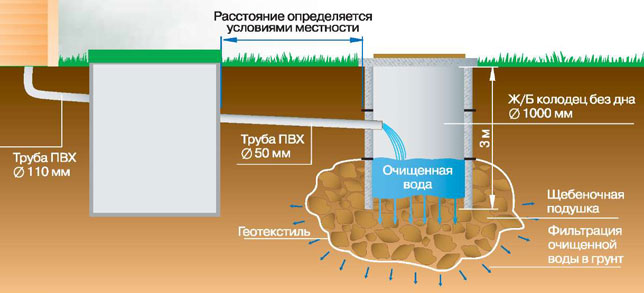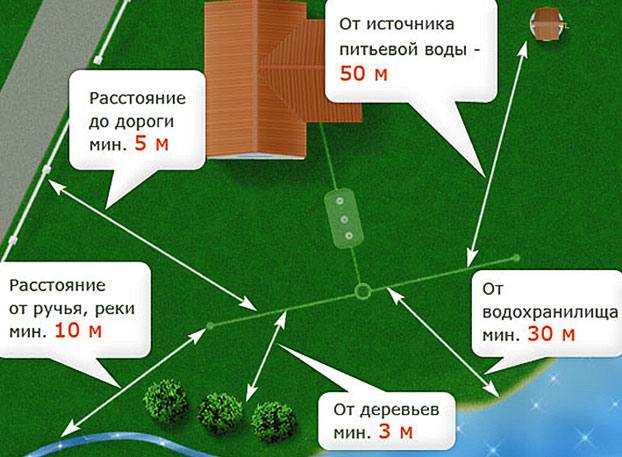1.
2.
3.
4.
Usually, in private households, the problem of sewage and sewage disposal is solved by building cesspools on household plots. There are certain standards that clearly prescribe how the process of arranging septic tanks and other treatment facilities serving individual residential buildings should be carried out. They are not recommended to be broken.
When a cesspool is created, sanitary standards are regulated by the Law of the Russian Federation N52-FZ of 1999 "On the sanitary and epidemiological well-being of the population." The requirements specified in it are mandatory for citizens of the country.
Sanitary standards for cesspools
According to the text of the regulatory document, cesspools (see photo) must be built with a mandatory special filtration device, and they should not have a normal bottom under any circumstances, especially if the amount of drains exceeds one cubic meter during the day.At the same time, it should be noted that during the construction of a cesspool for servicing a heated house in which at least 4 people will live, the sump should be made with a special bottom.
There is no single answer, what should be the distance from the house to the cesspool. The requirements for this parameter are ambiguous. The minimum distance between these two objects is 15 meters (read also: "").

Such a distance is required from the house to the drain pit so that the toxic gases emitted by the waste do not harm the environment on the ground and the people living in this area.
If there is a need to make the distance from the pit to the water supply closer, then you should contact the appropriate authorities (Sanepidemnadzor) and utility service companies (for example, water utility management, etc.).
Rules for arranging cesspools
If a cesspool is being built, sanitary standards must be observed. Sedimentation tanks with a working volume of not more than one cubic meter of sewage and sewage per day belong to the classic version of cesspools for servicing summer houses and country houses, in which people live in intermittent conditions and water heating equipment and household appliances are not used.According to sanitary requirements, the distance from the septic tank to the summer kitchen cannot be less than 5 meters. In the event that the daily volume of wastewater reaches 8 cubic meters, the distance should be increased to 8 meters.
The rules for arranging cesspools provide for compliance with a number of requirements:
- when the drain per day is 3 cubic meters - the pipes must be located as close as possible to groundwater (distance 40-50 meters);
- pipes should be mounted upwards relative to the flow of groundwater;
- if there is an artesian source in the immediate vicinity of the house, the distance from the well to the cesspool should be at least 20 meters.
SanPiN 42-128-4690-88: requirements and standards, installation distance
On the territory of the Russian Federation, regardless of the region of residence, SanPiN requirements for cesspools apply.When there is no centralized sewer system in a private house, its owners are allowed to locate a cesspool on the site. The main requirement for it is mandatory water resistance. Above the sump there should be a lid to close it and a special grate. You can equip a common drain pit with neighbors.
When a private house is located near a school or kindergarten, then the distance should be at least 20 meters. If you have any questions regarding the arrangement of a cesspool, the owner of suburban real estate should contact the local administrative authorities.
But there is a general rule for all private households - the sump should be located so that the distance from the well to the cesspool is 50 meters.

Treatment facilities must be cleaned at least once every six months.
When disinfecting drain pits, a product is used, the components of which are:
- 5% sodium hypochlorite;
- 5% - creolin;
- 10% lime chloride;
- 10% - naphthalizol;
- 10% - sodium metasilicate.
Additional requirements for the arrangement
- In addition to the requirement, what should be the distance between the well and the cesspool, there is another important point - this is the tightness of the treatment plant so that sewage does not poison the soil and aquifers, since in this case the environment will be harmed.
- The building materials used in the arrangement of sedimentation tanks (bricks, boards, blocks) must differ in density
- Drains should not be allowed to be above the mark of 35 centimeters from the ground surface, since then the owner of the property himself is unlikely to be able to cope with the negative consequences.
- from the water supply from asbestos-cement pipes to septic tanks and drain pits, the distance should not be less than 5 meters;
- when using cast-iron pipes with a diameter of not more than 200 millimeters - 1.5 meters;
- in the presence of pipes made of cast iron with a diameter of more than 200 millimeters - 3 meters;
- to gas pipes - more than 5 meters.


















